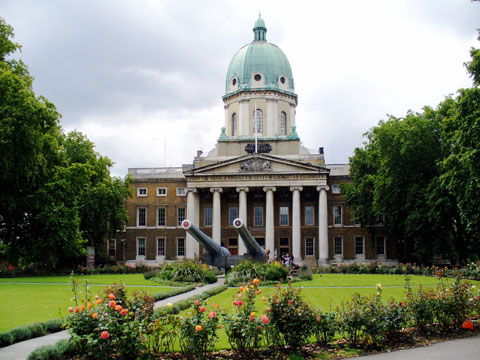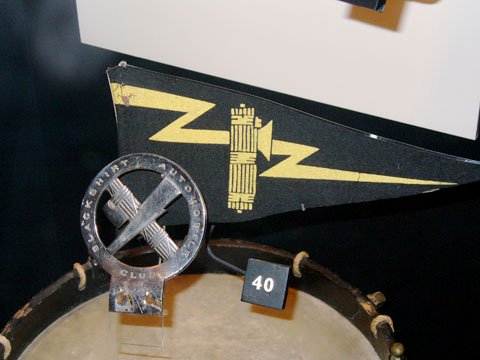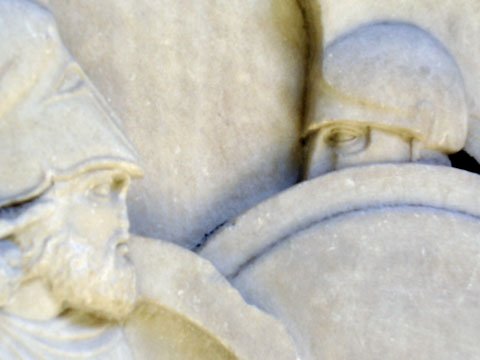
Sunday no. 4 was the occasion (after the spooky Big Ben) for my visit to the Imperial War Museum London, which of course was always going to be a highlight of my sightseeing here.

The building itself was not quite what I expected, however. While aesthetically pleasing, it doesn't seem grand enough, somehow. What I didn't realise, before my visit, was that it was not purpose built for the IWM: it was originally Bedlam. I suppose I'm comparing it with the Shrine of Remembrance in Melbourne, and the Australian War Memorial in Canberra. Both of these were built after the First World War; they are wholly or in part memorials to the war dead, and both are visually very striking. I am reliably informed that the IWM has a memorial function as well, at least in intention, but I have to say this didn't really come across -- not when compared with the AWM, for example, which although it too is mainly a museum, is centred around the Hall of Memory (with the Tomb of the Unknown Soldier), leading up to which is a long reflective pool and an eternal flame, enclosed by cloisters, along the walls of which are the names of over a hundred thousand Australians who have died in war. I wonder what it says about the different ways in which Australians and Britons remember their wars?
Those huge guns, by the way, are from the battleships HMS Ramillies and HMS Resolution and are of 15-inch calibre. And, to be fair, I must point out that the biggest gun at the AWM is only a 12-inch one, from the battlecruiser HMAS Australia :)

Alright, enough of that, get on with the cool stuff already. This is (part of) the Large Exhibits Hall, the first room visitors see. And yes, they are all large exhibits! In this photo there's a He 162 "People's Fighter" (though as far as I know, there wasn't one in every garage) and a Sopwith Camel (to which the roundel at the top of the post belongs); below them, a Polaris sub-launched ballistic missile (AKA Britain's "independent" nuclear deterrent); and around that, a T-34 tank, a Jagdpanther tank destroyer and a French 75.

I couldn't work out what this was at first. It was obviously something aerial, First World War-era by the looks of it -- I'm ashamed to say I had to read the sign to find out that it's actually a Zeppelin observation car, which was dropped on a long cable underneath the airship in order to get location fixes below cloud cover. That is to say, with a man inside, who would give directions to the Zeppelin by telephone. It is thought to have been lost from LZ90 on the night of 2 September 1916.

Genesis of the Daleks? Well, no, actually it's a Churchill Mark VII infantry tank.

Now this was rather impressive. It's a British 1650-lb bomb -- from the First World War, not the Second. It's over 6 feet tall. According to the caption, four bombs of this type were dropped by O/400 bombers -- presumably from Trenchard's Independent Force -- in an October 1918 raid on Kaiserslautern (which was to suffer much more destruction from the air in 1944). Behind are naval and artillery shells ranging from 14 to 18 inches.

A close-up of the Jagdpanther pictured earlier. According to the sign, it was knocked out by Allied gunfire and I assume these holes are the damage.

I spent most of the rest of the afternoon in the basement, in the permanent displays relating to the wars of the twentieth century -- I thought they did a very good job of contextualising the items on display. This is a bronze eagle from the Speer-designed Reich Chancellery -- Hitler's office building -- (in)complete with bullet holes from the Battle of Berlin.

Take cover -- it's a Zepp! Just kidding, it's only a photo of a model of a Zeppelin, L33, which was forced down at Little Wigborough on the night of 24 September 1916 after a raid on London, and reverse engineered into the successful British airships, R33 and R34.

The badge and pennant of the Blackshirt Automobile Club; Malcolm Campbell supposedly displayed something like these on Bluebird.

Why, it's an old friend, C 5422. The RAF Museum had a similarly huge reproduction on display. Somebody really should say something ...

Some of the most interesting displays were those relating to ARP. I had no idea about things like the mustard gas detector paper shown above. Mustard gas is actually usually a liquid under normal conditions, with a boiling point of just 14° Celsius. So it is persistent and lies around in pools and drops, waiting for some unprotected soul to blunder into it. Hence the detector paper:
If after a raid you notice suspicious patches on walls, floors, doors, etc., fix of piece of Gas Detector Paper about 5 ins. x 3 ins. to a stick, and apply to the suspicious patches. If Mustard Gas is present the Gas Detector Paper will instantly turn PINK.

A charred roof tile from Hiroshima.

Back in the Large Exhibits Hall. A Spitfire showing off its elliptical wings.

A Be2c of the Royal Flying Corps. You can see the roundels on the top of the upper wings from underneath, which shows how thin the canvas is.

The Spitfire's rival in beauty, the P-51 Mustang. Drop tanks ftw.

I didn't catch what these were about -- children's drawings near the entrance, evidently something to do with the camouflage exhibition so maybe it's this. They all seemed to have an anti-gun theme (not anti-war as such), so I wondered if that was spontaneous or had they been coached to draw to that theme? Still, they were rather touching.
I didn't get a chance to see the IWM's art collection, or the Falklands exhibition, or a bunch of other things. Nearly everywhere I go, I keep saying "I'll have to go back", but that's looking less and less likely as my time here draws to a close!
![]() This work is licensed under a Creative Commons Attribution-NonCommercial-NoDerivatives 4.0 International License.
Permissions beyond the scope of this license may be available at http://airminded.org/copyright/.
This work is licensed under a Creative Commons Attribution-NonCommercial-NoDerivatives 4.0 International License.
Permissions beyond the scope of this license may be available at http://airminded.org/copyright/.





mercuriuspoliticus
"I wonder what it says about the different ways in which Australians and Britons remember their wars?"
This is an interesting thought - the inclusion of specific areas of remembrance, rather than just exhibits, is something I've noticed about some US museums too. Whereas I think London's areas of remembrance are elsewhere - the Tomb of the Unknown Soldier and the Cenotaph. It's interesting that the UK ones are outside the PM's house and in the place where monarchs are crowned and buried - does that say something about what or who the dead have died for...
Brett Holman
Post authorThat's a good point, London already had focal points for commemoration, which could be repurposed for the World Wars. They could be incorporated into pre-existing traditions. As a new (and planned) city, Canberra certainly didn't have anything like that. I don't think Melbourne would have either, aside from a few cathedrals: though we don't bury people in them, and anyway as Australia has no state religion and is confessionally divided, it would be hard to make them the sites of memory for the community as a whole. So, the answer I guess is to create a site of memory rather than adapt an existing one. Although that does beg the question of why they didn't find some way to use that other Melbourne shrine :)
Alex
The He-162; the only aircraft whose design brief included the requirement that it had to be simple enough to be built by slaves. And one of the most wildly dangerous crates in which Man has ever attempted to fly; three of them were brought back from Rechlin to RAE Farnborough for evaluation, and in two days, two had crashed with the deaths of two senior test pilots. They decided to stop after that; hence there's one in the museum!
Jakob
I always thought Bedlam was a curiously appropriate venue for the IWM. The gardens are lovely and peaceful, too. If you can get away from the school groups. If you're in London on the 15th and 16th of September, you can see the reading room and dome for Open House London.
On mustard gas: Early-war British fighters had a square yellow gas-detector patch on the upper wing; as gas seems unlikely to have been an effective aerial weapon, perhaps this was to ensure that the home airfield was safe upon landing?
On the kids' drawings: Lambeth is a notoriously rough borough - I suspect this is as part of an anti-gun-crime and anti-knife-crime initiative.
Jakob
Alex: Although, curiously, Winkle Brown rated it and its handling qualities rather highly. Admittedly, being the greatest test pilot that ever lived probably gives you some advantage over the glider-trained Hitler-Jugend that were supposed to fly it...
Alex
Well, there's always one..ISTR Hanna Reitsch thought it was a death trap, if that helps.
Alan Allport
When I was working on my dissertation in 1995 I used to eat my packed lunch next to the Jagdpanther: the coolest place I've ever taken a scotch egg ...
Brett Holman
Post authorAlex:
I'm often curious as to how such-and-such an item got into a museum's collection, so thanks for filling me in on one of them :)
Jakob:
Well, presumably I'll get to see the IWM reading room when I'm there as a legitimate historical researcher :D Being an historian has its privileges. Very few, admittedly ...
Fascinating about the mustard gas detector on the wing. I think you're right that it would have been to see if the airfield was contaminated. There wasn't a lot of pre-war attention given to the idea of using gas against aircraft -- though having said that I came across an example today ('It would be much simpler to surround attacking air-planes with enormous clouds of gas than to score a direct hit on each one', F. N. Pickett, Don't Be Afraid of Poison Gas , 1934) -- and anyway, mustard wouldn't be used for that as it's too heavy.
Alan:
Well, it beats the tearoom at Colindale!
david tiley
Fascinated to see the Zeppelin observation car. I had an attack of the smugs in about 1980 when I discovered it somewhere in the dustier bits of the IWM leaning against a wall as if it had been abandoned. Even without the label I knew what it was (swank swank).
I have a feeling it was actually occuppied when the Germans dropped it by mistake.
They had a foul reputation. Dangling 5000 feet under the gondolas, connected only by wires and a microphone, they tended to swing back and forth in a huge arc as the inhabitant threw up all over himself. That was probably better than balancing on the engine chipping frozen oil off the uncovered sump with a chisel and feeding it back into the top.
Pingback:
Airminded · The IWM and memory
Chris Williams
"F. N. Pickett, Don’t Be Afraid of Poison Gas , 1934"
How Brett is that reference?
If you can find the time - even if you're just nipping out for a break from your research - check out the paintings. Especially 'Gassed', though right now you need to walk through the first room of the Falklands exhibit to get to it. Nevinson's _A Taube_ is also on show in that room, so it's relevant.
Brett Holman
Post authorDavid:
You get double "Spotto!" points for that! The IWM's blurb says that it 'was apparently being lowered unmanned when the winch went out of control'. I'm not sure why they'd want to lower it unmanned though ...
Chris:
I'm way ahead of you, Chris -- well, a day ahead, anyway! I used the IWM reading rooms yesterday and since they close at 5pm but the museum itself is open until 6, used the extra hour to look at the Falklands and some of the art. I actually didn't notice the WWI art gallery though, until just about closing time, but I'll be back there on Tuesday so can have a look then. The same situation obtains with the RAF Museum and reading rooms also, so at least I got to see the fighters.
graham bagwell
What can you tell me about mustard gas patches painted on RAF bombers in WW2? (Ahead of upper turret on Lancasters). What was purpose?
Many thanks Graham Bagwell
Brett Holman
Post authorSorry, Graham, I can't tell you anything specific, only what we've speculated above -- that it was designed to tell the aircrew whether the airfield was safe, once they'd landed.
Julian J
As a london resident interested in military history, your comments made me see things with a fresh eye. Thanks.
I agree with the other poster that Bedlam is where the IWM should be sited, even British bureacracy has its characteristic sense of humour.
I suspect that the childrens' paintings are something to do with gun crime - in London we have had a spate of shootings of teenagers, including an 18 yr old neighbour of mine. Various initiatives are trying to alert schoolchildren to the problems of guns.
Brett Holman
Post authorThanks, that sounds plausible.
Pingback:
WW I aircraft on display in London - The Aerodrome Forum